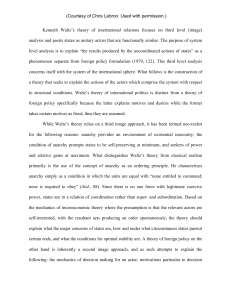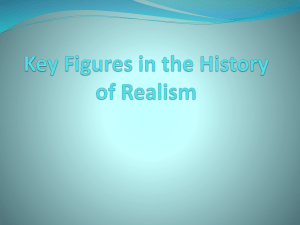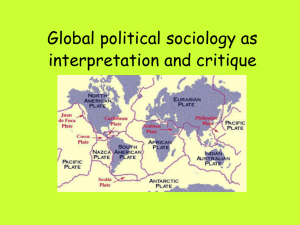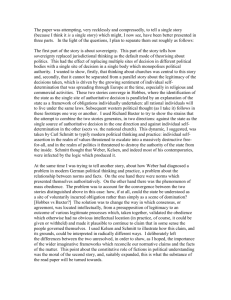Notes on Waltz
advertisement
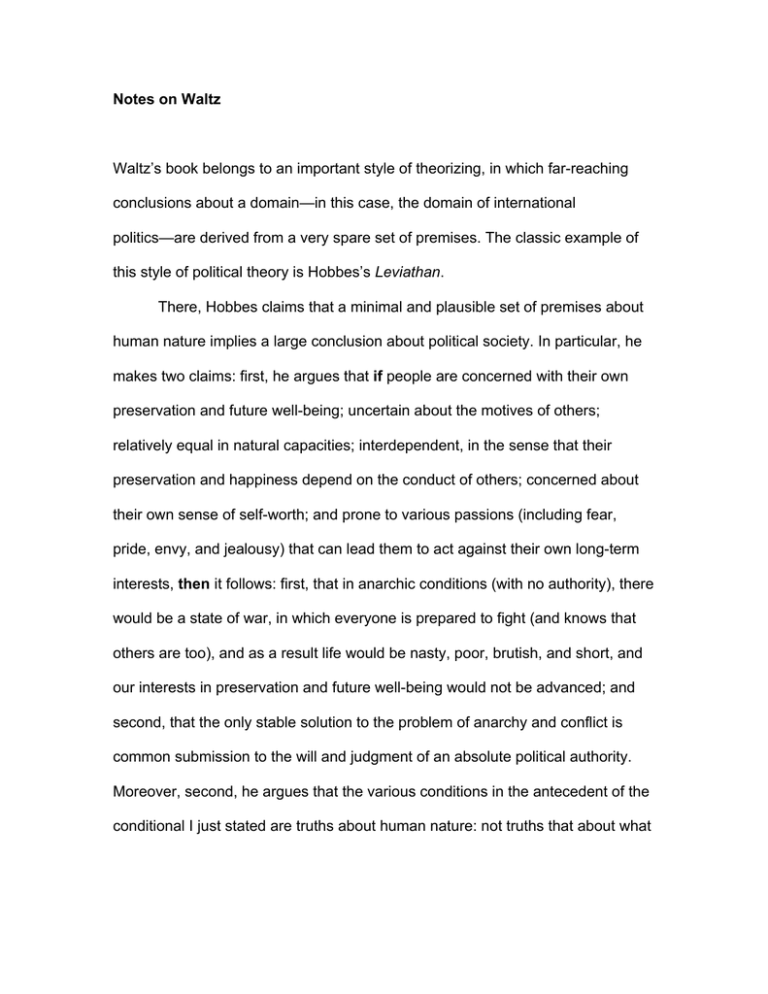
Notes on Waltz Waltz’s book belongs to an important style of theorizing, in which far-reaching conclusions about a domain—in this case, the domain of international politics—are derived from a very spare set of premises. The classic example of this style of political theory is Hobbes’s Leviathan. There, Hobbes claims that a minimal and plausible set of premises about human nature implies a large conclusion about political society. In particular, he makes two claims: first, he argues that if people are concerned with their own preservation and future well-being; uncertain about the motives of others; relatively equal in natural capacities; interdependent, in the sense that their preservation and happiness depend on the conduct of others; concerned about their own sense of self-worth; and prone to various passions (including fear, pride, envy, and jealousy) that can lead them to act against their own long-term interests, then it follows: first, that in anarchic conditions (with no authority), there would be a state of war, in which everyone is prepared to fight (and knows that others are too), and as a result life would be nasty, poor, brutish, and short, and our interests in preservation and future well-being would not be advanced; and second, that the only stable solution to the problem of anarchy and conflict is common submission to the will and judgment of an absolute political authority. Moreover, second, he argues that the various conditions in the antecedent of the conditional I just stated are truths about human nature: not truths that about what human beings are like in some circumstances, but simply about what human beings as such are like. Now, there are certain important substantive analogies between Waltz’s view and Hobbes’s, but I am not here interested in those points of substantive overlap. I am interested instead in the fact that both draw sweeping conclusions from an apparently spare set of assumptions—in Hobbes’s cases, assumptions about people; in Waltz’s case, assumptions about the position of states—and that they take those assumptions to be very broadly true. Correspondingly, in evaluating their arguments we need to ask two questions: (1) do their conclusions follow from the premises? So, in the case of Hobbes we want to know whether the assumptions about people, once they are reasonably precisely stated, really do imply that the state of nature would be a state of war, and that the only stable alternative is political absolutism. At least one strand of Lockean criticism of Hobbes says that you can, arguing from basically Hobbesian premises, defend a more limited, constitutional government; (2) second, if the conclusions do follow from the premises, then we want to know whether the premises really have such broadly applicability. So one strand of Rousseauean criticism of Hobbes says that, while it may be true that political absolutism is required to preserve a stable peace among Hobbesian agents, nevertheless, Hobbes has not described human beings as they are by nature, but rather as they have become—as their many possibilities have been expressed—under one possible set of social conditions. The two lines of criticism are different: the first suggests that the premises themselves are less constraining of political possibilities than the argument supposes; the second allows that the premises may be very constraining, but then argues that the premises themselves are more historically specific than they are presented as being, and need not be taken as fixed. But the two lines of criticism converge in suggesting that the range of social and political possibilities is wider than the theory tells us. That is an important result. So in exploring Waltz’s theory, we want to know three things: (1) what are the central claims he defends about the conduct of international politics; (2) what are his premises about states and their relations; and (3) do his premises lead to his conclusions? The reason for pursuing the exercise is not to quibble about logical gaps, but to see whether the space of possibility is greater than Waltz’s argument might suggest. 1. What are some of the implications that Waltz draws from his structural/systems theory of international politics? Central claims about how states conduct their business in relation to one another. • International politics is a self-help system (principle of action), unlike domestic politics. This appears to have both an organizational and a motivational interpretation: (i) organizationally, agents (states) must be prepared to defend themselves, whereas in domestic system an organization provides protection against private force; (ii) motivationally, states “act for their own sakes” (112); “for their own interests” (113); “security is the highest end” (126). More particularly, states typically use the methods described by the idea of Realpolitik (117): (a) state’s interest provides the spring of action; (b) what states need to do is determined by the “unregulated competition of states”; (c) can work out policies that serve these needs by calculation; (d) test of success is survival and strengthening state. Question we want to ask is: is it true that international politics is a self-help system, and if it is a self-help system in the organizational sense, then why do states use the methods of Realpolitik? What other methods for the conduct of policy might be used? • The state system tends to a balance of power: (i) as to the balancing part: we see balancing rather than bandwagoning (siding with the more powerful), or buckpassing that does not lead to balancing (not that there is no buckpassing, but that it happens when someone else can be expected to pick up the slack); (ii) as to the power part, states balance against power or capabilities (correct for imbalances of power), not against threats: the distinction is that an assessment of threats requires an assessment of intentions. So for example, growth rate in military spending will be greater in less powerful state/alliance than in more powerful, regardless of any assessment of intentions: worried about what others can do to you, not in the first instance about whether they are likely to try; (iii) the policies that lead to balance involve alliances with surprising allies (France/Russia) and the adoption of surprising practices (large military spending by US after WWII) • States emulate (127-28) each other and are socialized into the norms of interstate competition, and the resulting of emulation and socialization is greater unity of conduct than of culture, regime, history: (i) they emulate military practices and doctrines of competitors, even when those practices and doctrines are at odds with their own aspirations and ideologies (consider the case of revolutionary regimes); (ii) states with different regimes and cultures adopt practices that are more common across states than would have been expected, given their differences. • States often fail to cooperate: (i) these failures hold, even when mutual gains are possible through specialization and associated interdependence, or by accepting a common set of rules (about the use of a resource, or the generation of a benefit), and when the possibility of such gains is well-understood; (ii) efforts to break out of these patterns of limited cooperation by adopting new policies and new agreements tend to break down. • Bipolar systems behave in fundamentally different ways from multipolar systems: (i) in bipolar systems, balancing principally takes the form internal efforts to increase the various bases of power (it could also take a more imperial or colonial form); in multipolar systems, balancing works principally through alliances (and divide-and-rule): this is the defining difference between bipolar and multipolar systems (163); (ii) bipolar systems are more stable than multipolar systems, where “more stable” means more peaceful (second meaning of “stability” has to do with enabling cooperation). 2. Structural Theory of these Patterns • Main explanation of these features is structure of system: (i) structure is an arrangement of parts: a system of relations among units (positions); (ii) not a characterization of the internal properties of the units themselves, whether their regimes, cultures, histories, aims, or capacities (except in relation to the capacities of others).. • Main structural distinction is between anarchy and hierarchy, as “ordering principles”: (i) international politics, the units are states; (ii) the basic relation between and among states is characterized by anarchy; (iii) in anarchy, no agent organized to prevent the private use of force (104), whereas in hierarchy there is a monopoly on the legitimate use of power. • Structural variation, given ordering principle: (i) distribution of capabilities, meaning numbers of major powers (or poles); (ii) the fundamental distinction, because of differences of alliance methods, is between bipolar and multipolar; (iii) power is multidimensional, and it is the cumulative effect of many dimensions that is expressed in an ordering according to capabilities, which include territory and population, • Structural explanation (causation): (i) consequences for conduct of relations between states follow from assumptions about structure, both anarchy itself, and distribution of capabilities; (ii) way that structure “causes” effects is either through competition/selection or socialization; (iii) not causation of an event by a prior event, or of a result as intended by an agent, but explanation of a pattern or regularity by reference to the constraints under which agents act. 3. Connections Between Structural Theory and Implications • What explains the use of Realpolitik methods? (i) one answer is that the characteristic aims of states are assumed or postulated: namely, that states pursue their interests, and that security is the highest interest. They are assumed, and then we see what results from the assumption. But Waltz says something different (117): that they are a product of structural constraints, in particular the constraints imposed by anarchy; (ii) so a second answer, of this structural kind, is that it is a matter of selection, on the model of natural selection, where the explanation of the pervasive presence of a trait in a population is explained by the reproductive success of organisms with the trait, and the failure of organisms that lack it: they “fall by the wayside” (77). So here the idea would be that, given the condition of anarchy, states that do not use Realpolitik methods go out of existence, like firms that go bankrupt (77). This argument gives substance to the idea of a structural constraint—of a structural cause that accounts for a result by operating as a constraint that reduces variation—but the trouble with applying it here is that states VERY rarely go out of existence; (iii) sometimes, it is said that states emulate other successful states, as part of a process of socialization: “if some states do relatively well, others will emulate them or fall by the wayside” (118). But it is not clear why we should expect emulation—of a kind that works to substantially reduce variation and lead all to Realpolitik methods— unless the emulation is necessary to survival, or we make some more substantial motivational assumptions about what drives political decision makers; (iv) important that Waltz wants to account for the use of these methods structurally, without depending on assumptions about the rationality or the psychology of decision makers: without relying on properties of the units, rather than the relations between units. • Why does anarchy lead to balancing of power? (i) the idea is that if states use Realpolitik methods, then • Why is bipolar system especially stable: (I) in a bipolar system there is very little interdependence among the great powers, in the sense of mutual vulnerability, and very little dependence of the poles on the periphery. Intuitive idea then seems to be that, if you are not very vulnerable, then you can be indifferent to a great deal of what happens: “the costs of, and the odds on, losing our trading partners, is very low” (159). So the great powers can do what they need to ensure their own security; (ii) in a bipolar system, no needs of great powers to make decisions through accommodation of other powers, which can produce rigidity rather than flexibility; (iii) in a bipolar system, there is a crisper sense of responsibility, because the major powers cannot expect problems to be addressed by other major powers (minimizes buckpassing); (iv) the stability of a bipolar system can be upset by changes anywhere in the system • The limits on interstate cooperation result from anarchical structure, in two ways (105-107): (i) because of concerns about the division of the benefits of cooperation, which may be damaging or destructive to security because the gains translate into power (concern about relative gains may not be so prominent in the domestic case, unless there is strong envy or zero-sum politics). So it is inconsistent with balancing to cooperate in a project that assigns a greater share of benefits to another state; (ii) because of concerns about dependence and the resulting vulnerability: “states do not willingly place themselves in situations of increased dependence” (107), so there are limits on specialization; (iii) because the undesirable results that come from failures of cooperation reflect the structure in international politics cannot be changed without changing the structure of the system of international politics. And changing the structure would impose large organizational costs, produce lots of conflict by establishing a large prize in the form of a central power, which would need to be very powerful to hold the hierarchy together (111-12).

